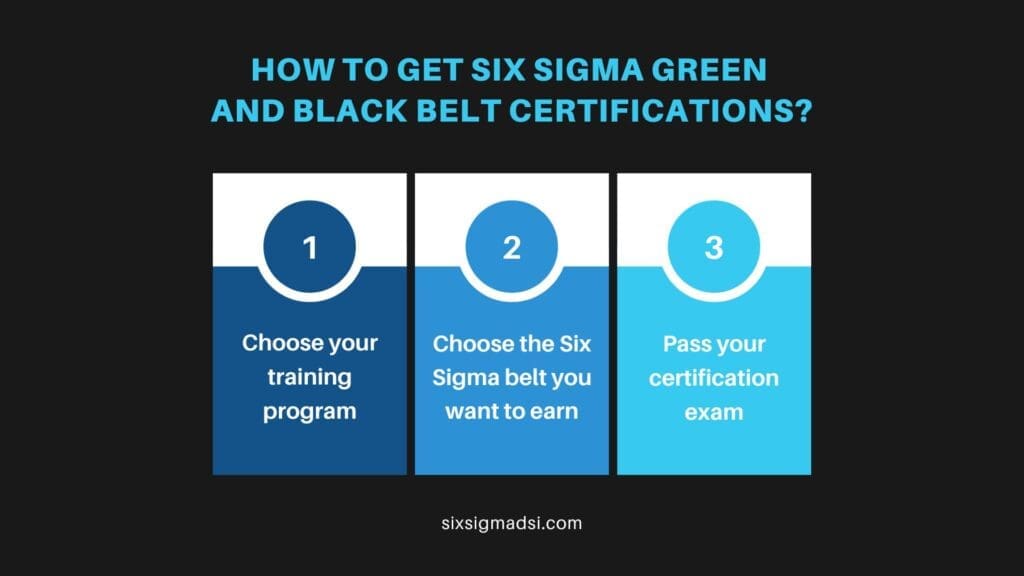Table of contents
- Six Sigma Black Belt vs. Green Belt: Key Differences
- What is a Six Sigma Black Belt?
- What is a Six Sigma Green Belt?
- Levels in Six Sigma
- What do Six Sigma Green Belts Do?
- What do Six Sigma Black Belts do?
- How to Get Six Sigma Green Belt and Black Belt Certifications?
- Benefits of Either Certification to Your Career
- Which Level is Right For You?
- Related articles
Estimated reading time: 8 minutes
Six Sigma Black Belt vs. Green Belt: Key Differences
Six Sigma certifications can be a great way for you to increase your leadership skills and quality assurance skills. This will be a benefit to your company. We will explain the differences between the Six Sigma black belt and green belt certifications and training and get the certification for it.
Many consider certification as a Green Belt or Black Belt the first step to becoming an expert in Six Sigma. Both allow professionals to take on larger roles in process improvement.
They may be grouped as Green Belts or Black Belts but they have their skills and roles in project teams. Certification can lead to better salaries and career prospects.
What is a Six Sigma Black Belt?
Six Sigma black belts are a level of certification that indicates an individual’s qualifications and a passing score on the Six Sigma blackbelt certification exam. Six Sigma black belts possess the knowledge and understanding of a green belt as well as a deeper understanding of Six Sigma. These people are often leaders in Six Sigma projects within their companies. They mentor, train, and supervise Six Sigma professionals at the lower levels.
Six Sigma black belts are responsible for delegating responsibilities to green belts and assigning them to specific projects. They then follow up with green belts and monitor the progress of different projects. Black belts also have to communicate with senior leaders on behalf of project teams. Six Sigma master black belt is the highest level of Six Sigma certification. Although master black belts may oversee Six Sigma black belts in certain instances, they are often independent.
What is a Six Sigma Green Belt?
Six Sigma green belt signifies that an individual has passed the Six Sigma greenbelt certification exam. They can solve quality problems, improve processes, and analyze them using Six Sigma. An interest in professional development is demonstrated by a Six Sigma green belt.
Six Sigma green belts are responsible for managing individual Six Sigma projects. Black belts provide regular progress updates. Six Sigma green belts often contribute their efforts to data collection and analysis. Six Sigma Green Belts can supervise and train Six Sigma Yellow Belts. To be able to assume more leadership roles within their companies, they may pursue black belt certification.
Levels in Six Sigma

Let’s first look at the Six Sigma levels.
- White belt: This is for beginners. For professionals with a working knowledge and understanding of Six Sigma methodology.
- Yellow Belt: This level is for professionals who are interested in Six Sigma principles. They will also learn how to create process maps in a project setting.
- Green Belt: Six Sigma experts who are certified as Green Belts. Green Belt certification requires you to pass a multi-choice test.
- Black Belt: This is the highest level for professionals who are skilled in Six Sigma tools and techniques. They are also able to lead project teams. Black Belt certification is earned after completing a Six Sigma project and passing an exam.
- Master Black Belt: This is the highest level of Six Sigma mastery. Master Black Belts are the highest level of Six Sigma mastery. They mentor Black Belts and can influence enterprise-wide projects. They must also pass a certification exam.
What do Six Sigma Green Belts Do?

Yellow Belt Training opens your eyes to Six Sigma. They learn how to collect data for projects. This is not an easy task.
Green Belts go on to the next level. Green Belts specializes in DMAIC which is a fundamental Six Sigma methodology.
DMAIC stands for:
- Definition: Clearly outline and define the problem or opportunity for improvement.
- Measure: Understand the baseline performance metrics and establish a clear understanding of the existing situation.
- Analyze: Identify patterns, root causes, and areas for improvement. Use statistical tools and methods to gain insights.
- Improve: Develop and implement solutions to address the identified issues and improve the process.
- Control: Implement measures to prevent the recurrence of identified issues and continuously monitor the process for stability.
Many Green Belts work directly under the supervision of a Black Belt. They may also supervise Yellow Belts.
What do Six Sigma Black Belts do?
Black Belts have the same Six Sigma expertise and techniques as Green Belts. They also have a better understanding of how Six Sigma methodology can help achieve business goals.
Green Belts analyze and collect data. Black Belts are usually full-time even though they might hold a lower rank (Green Belts included).
Black Belts play an important role in communication with executives. They generally act as the bridge between the project team and the company’s leaders. This requires an ability to make strategic plans and find ways that a Six Sigma project will benefit those plans, as well as being able to put together reports that sum up the data findings of project teams.
Green Belts and Black Belts play key roles in accomplishing process improvement through Six Sigma. For those who wish to take on a higher-profile role in managing change at their organization.
How to Get Six Sigma Green Belt and Black Belt Certifications?

These steps will allow you to achieve both a Six Sigma green and black belt.
- Choose your training program
Six Sigma certifications can only be obtained by completing a recognized training program. Two national organizations have strong reputations for quality certifications, the American Society for Quality for Six Sigma (ASQ) and the International Association of Six Sigma Certificate for Lean Six Sigma (IASC). Accreditation is not required. It is essential to ensure that your training meets the standards. To be eligible for a grant, you will need to complete certain programs. There are three different methods: in-person, online with live sessions, and self-paced. The course length can be different, some can be less than 2 days while others can take up to a week.
- Choose the Six Sigma belt you want to earn
Next, decide whether you want to become a Six Sigma Black belt or a green belt and where you will be training and getting the certification. These requirements include specific work experience and the completion of a minimum amount of projects.
Green belt requirements are more strict than those for black belts. Master black belt requirements are more stringent than green belt requirements.
- Pass your certification exam
The structure of your certification exam can vary depending on how you’re studying Six Sigma and Lean Six Sigma. The test time limits can be between three and five hours, depending on which level you take.
Benefits of Either Certification to Your Career
Six Sigma Black and Green belts are a great way to improve your professional skills and help your company. These are some of the benefits that Six Sigma certification can bring to your company or organization:
- Gain hands-on experience. You may be required to complete a project in real life if you are preparing for the Six Sigma exams or taking Six Sigma training.
- You can become more valuable in other industries. Six Sigma training isn’t limited to one industry. Six Sigma can help you become more valuable in all types of businesses.
- Boost your qualifications. Six Sigma certifications may be desirable for hiring managers who are focused on quality control.
- Your chances of being promoted are increased Your Six Sigma belt is evidence that you have a certain level of knowledge and capability. It also shows your leadership skills.
Which Level is Right For You?
After you have chosen the best provider, your first decision is to determine which level of Certification will best suit your goals. The amount of knowledge offered is a major difference between the Six Sigma Black Belt, Green Belt, and Yellow Belt. Students are provided with more information about the Six Sigma Method because the Black Belt Certification is more complex and longer.
Both the Black Belt and Green Belt Six Sigma positions can be very difficult and require a lot of certification training. Although the Yellow Belt is not as intense, it is a great starting point for higher levels. Once students have gained real-world experience, the pieces of this puzzle will all fit together.
About Six Sigma Development Solutions, Inc.
Six Sigma Development Solutions, Inc. offers onsite, public, and virtual Lean Six Sigma certification training. We are an Accredited Training Organization by the IASSC (International Association of Six Sigma Certification). We offer Lean Six Sigma Green Belt, Black Belt, and Yellow Belt, as well as LEAN certifications.
Book a Call and Let us know how we can help meet your training needs.




















if I want to achieve black belt, could I have certified green belt first or not
Hello Pijush, thank you for your inquiry. You can obtain a Green Belt certification first. However, to qualify for our Black Belt course, your Green Belt certification must be from either IASSC (iassc.org) or ASQ (asq.org). Alternatively, if you don’t currently hold a Green Belt certification, you can enroll in our Public Lean Six Sigma Green Belt course. Completing this course will allow you to attend our Black Belt course directly without the need for prior Green Belt certification. This option is part of our Fast-Track program to Lean Six Sigma Black Belt certification. If your goal is to achieve Black Belt certification, you can find more details about our Fast-Track program here: https://sixsigmadsi.com/six-sigma-black-belt-fast-track-program/.